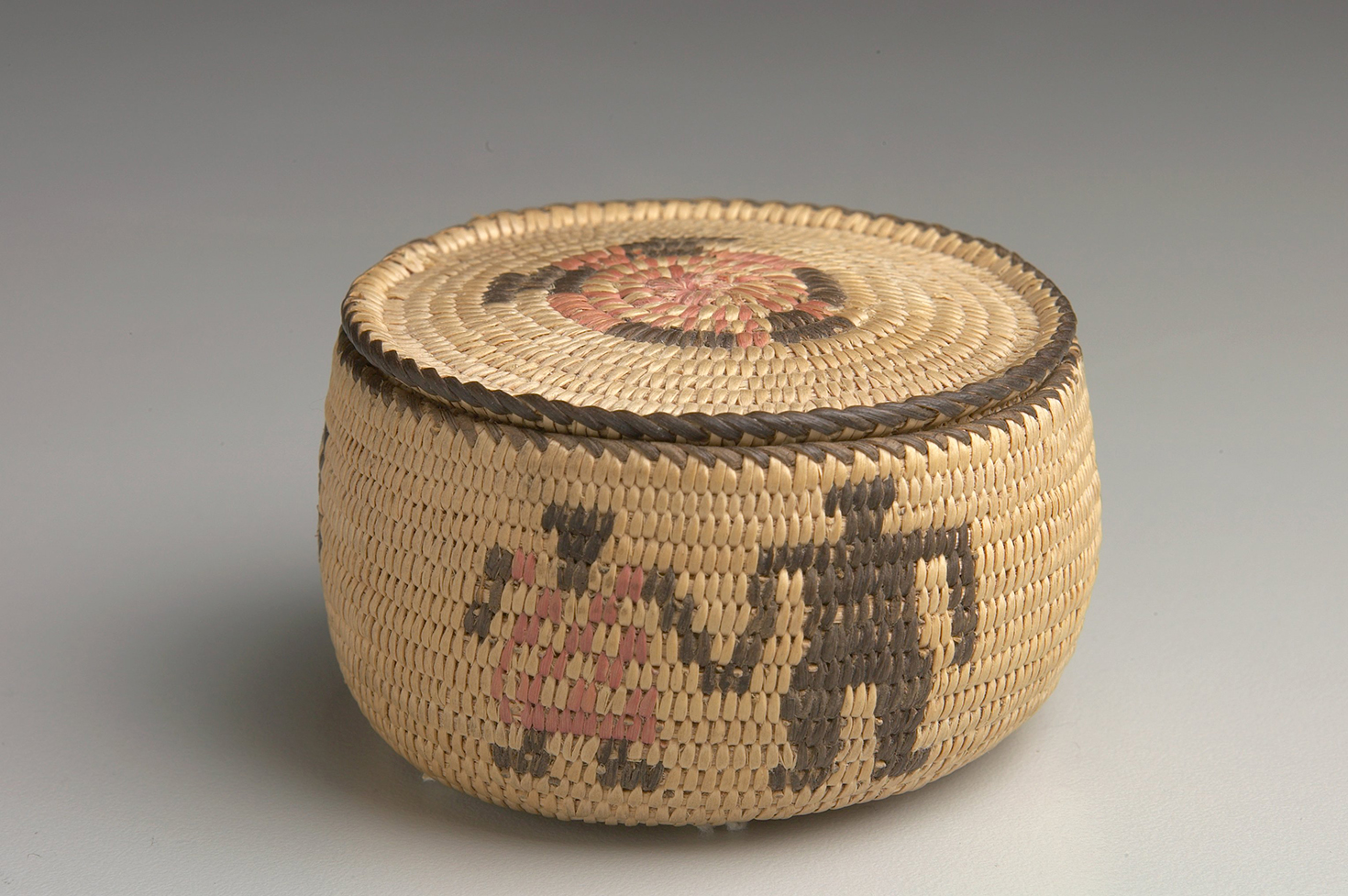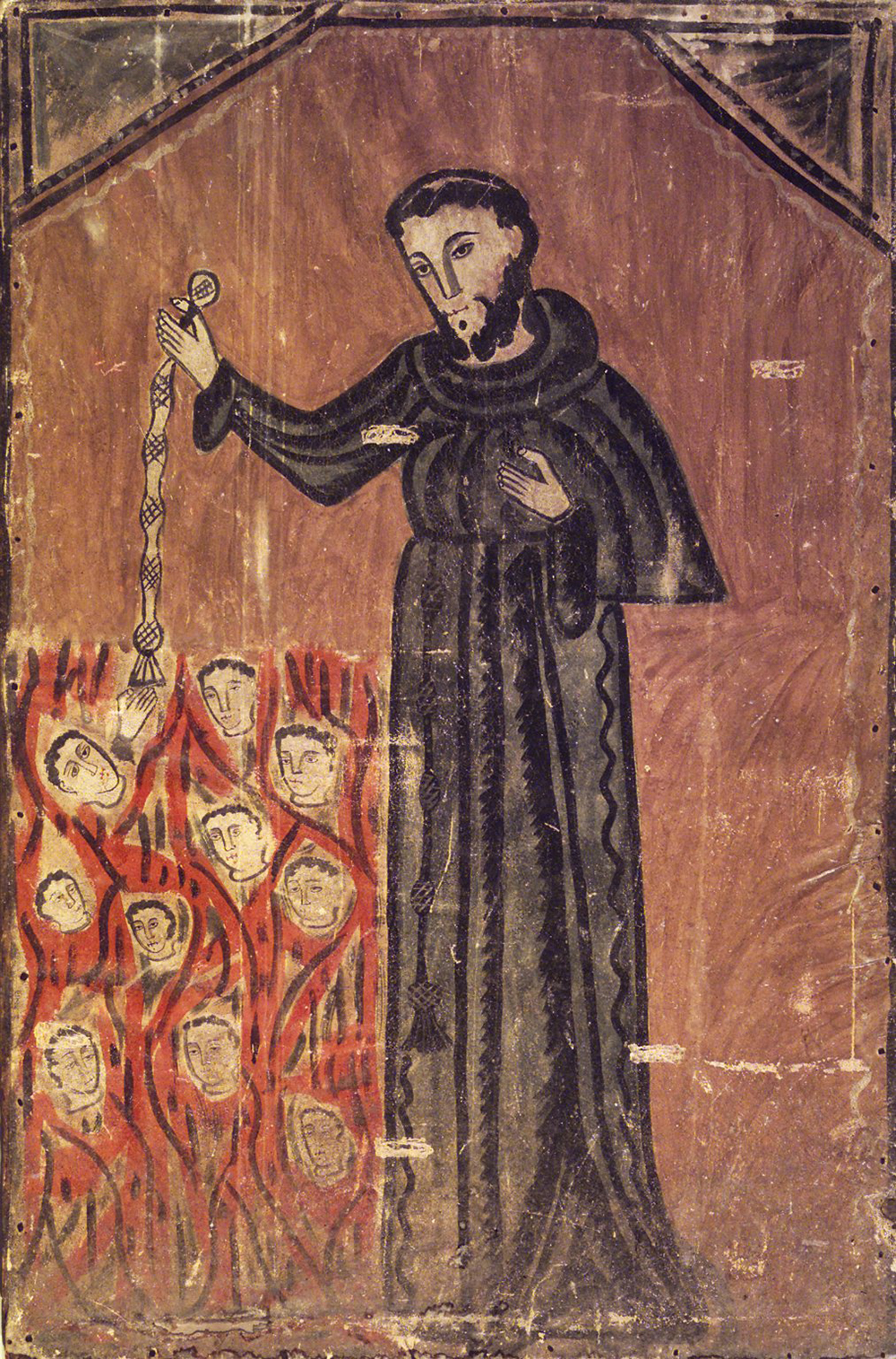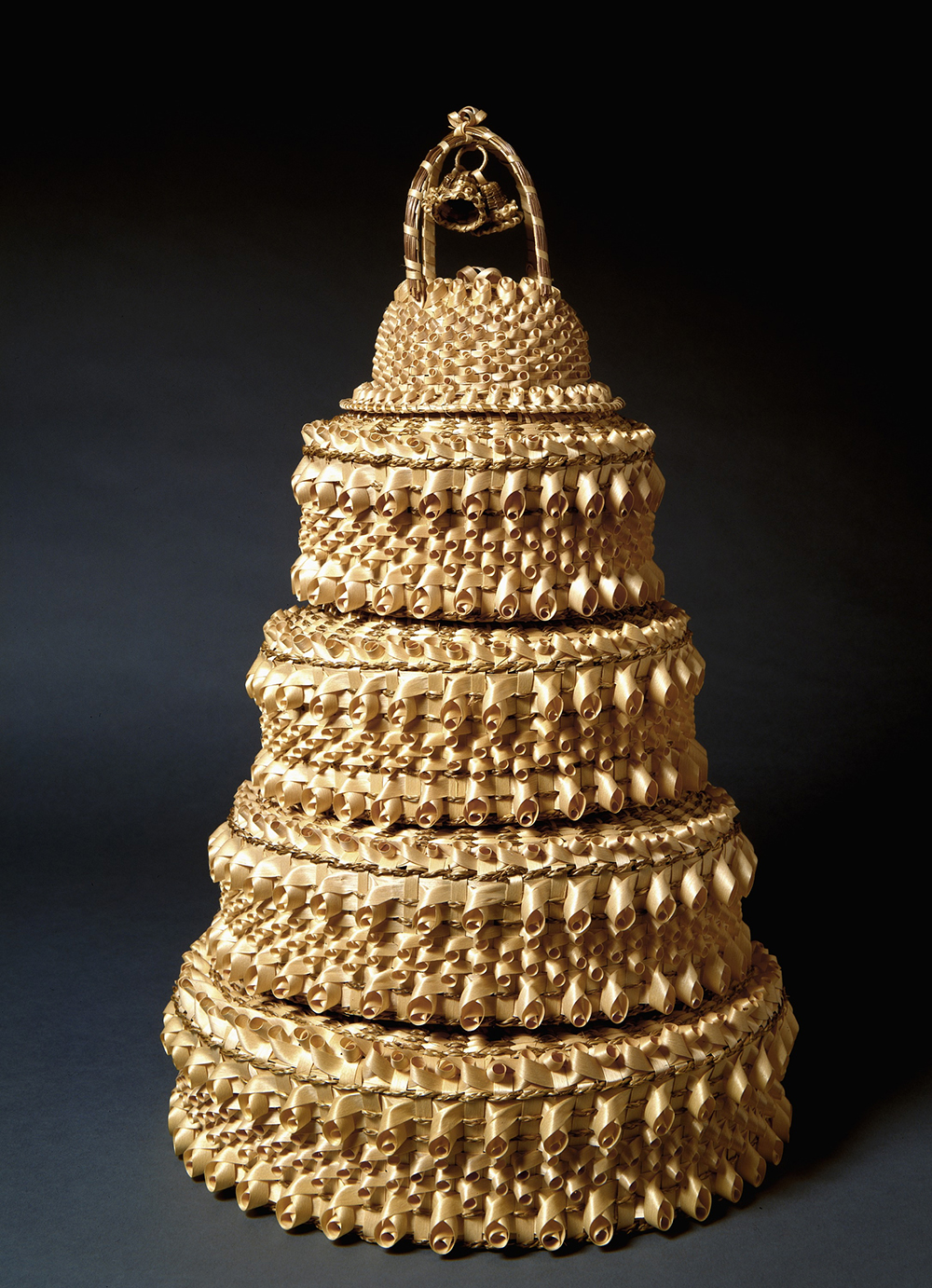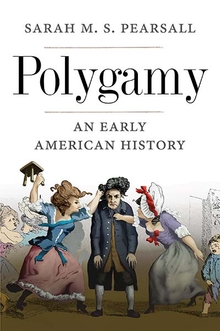
Miniature basket, twentieth century. The Minneapolis Institute of Art, Gift of Mrs. C.C. Bovey.
Makheabichtichiou was blessed with courage, an agile tongue, the respect of his people—and three wives. Paul Le Jeune, first superior of the Jesuits in New France in what is now Canada in the 1630s, praised him for all these qualities but the last. Thanks to his talents, Makheabichtichiou became leader or “capitaine” of La Petite Nation, a collection of Algonquin and Innu (or Montagnais) refugees clustered together north of the St. Lawrence River in a difficult period of reconfiguration following epidemics and war. Eager to further trade and diplomatic ties with the French, he converted to Christianity, establishing an alliance with the Jesuits (or Black Robes), who welcomed him warmly. Makheabichtichiou agreed to renounce all the customs that the Jesuits condemned: “that he would never give eat-all feasts, that he would not summon the Sorcerers to treat him in his sicknesses, that he would no longer believe in dreams, and that he desired to be baptized and to believe what the French believe.” This offer showed just how courageous he was, because it demonstrated his willingness to compromise many sources of political authority. Feasts where leaders furnished hospitality, thus demonstrating the prosperity of their households, were important markers of status. The connections nurtured by “sorcerers,” animal spirits, and dreams also enhanced the ability to lead. Still, Makheabichtichiou made clear his readiness to depart from the dreamscape of Bear and Beaver, the Algonquin way of life. He was such an enthusiastic convert that he even proclaimed the “wonders of our Holy doctrine, preaching it publicly.”
Here, then, was sweet triumph for the Jesuits. It had not been an easy mission. Le Jeune and others found this new land forbidding, its people disconcerting. Indeed, Le Jeune termed the Native house in which he had wintered “a dungeon which had neither lock nor key.” The guard was “the cold, the snow, and the danger of getting lost in these great woods”: pressing fears for inexperienced French travelers. To ward off the bone-chilling cold, a huge fire burned, leading to roasting heat and choking smoke that burned eyes and lungs, what Le Jeune, in sardonic reference to Christian saints, called “martyrdom.” Then there were the dogs, “great and in great number,” hungry, smelly dogs, scampering on people and things, thrusting their wet noses into any dish of food. Le Jeune complained that he could not even stand up in these suffocating, stinking houses packed with the bodies of men, women, children, and dogs: “Consequently you must always lie down, or sit down upon the ground, the usual posture of the Savages.” In other words, this Frenchman felt compelled to lower himself to fit in this new kind of household. Yet such “martyrdom” seemed worth it when Makheabichtichiou turned to Jesus. Schooled in hierarchy, Le Jeune assumed that the conversion of this bold capitaine would effect the Christianization of his whole people. For all their learning, how little those Black Robes knew sometimes! No sooner had Makheabichtichiou shown himself a good Christian in so many ways than the Jesuits’ hopes started to unravel. He agreed to everything they wanted—with one critical exception. He “kept all the commandments, except that one about having only one wife.” His obdurate refusal to renounce his three wives prevented his baptism and, in Jesuit eyes, rendered the whole mission a failure. It was a crushing blow, experienced repeatedly in the colonial period. Across numerous locations in colonial America, as we have seen, missionaries kept meeting powerful Native men who professed belief in Christ and his church yet who would not give up polygyny. Such “gave us all some trouble,” as Le Jeune later phrased it.

Historians of such encounters, following the missionaries, have usually focused less on how such plural marriages seemed to people like Makheabichtichiou and his wives than on how they seemed to people like Le Jeune and the missionaries: an “obstacle,” a “target,” “disorder,” and “savagery.” Much more can be said on the Indian side of this history.
Native Americans and French men came together in these novel encounters, mostly with peaceful intentions, but also wary and armed: men like Makheabichtichiou with arrows and arquebuses, men like Le Jeune with quill and paper. Each kind of tool shaped the encounters themselves, as well as the ways they have been narrated. Like many officials who left abundant writings about people who left none, Jesuit missionaries such as Le Jeune recorded in order to obliterate much of the behavior that they were observing. They wrote about polygamy and divorce because they wanted to replace them with lifelong monogamy or, better yet, celibacy.
After all, ending infractions of the sacrament of monogamous Christian marriage was part of the Catholic global mission. Early modern Jesuits around the world, in the courts of Kongo and Mughal and Native American rulers, spent a lot of time arguing for perpetual Christian monogamy, even for kings: a message rarely greeted with much enthusiasm. They also wrote about it.
Jesuits wrote reports home (edited before publication); they also wrote dictionaries for each other to help new missionaries. The former source has been used a lot, the latter rarely. These dictionaries capture extraordinary information, even as they also expose French judgments and incomprehension. This very complication of language highlights the complex, fluid nature of identities in seventeenth-century Native America. Algonquian is a very wide linguistic designation. It includes many people, such as those in the wider areas of the Great Lakes and north of the St. Lawrence River. A contemporary map shows the northern regions. The focus here is on three distinct linguistic subgroups in those regions: Algonquin/Algonkin (of the Ottawa River valley), Innu (or Montagnais), and Miami-Illinois. Each linguistic subgroup included smaller entities identified specifically by the French, such as the Peoria Illinois. There was considerable variety within and between them; the Miami-Illinois were the most hierarchical, with the most established practices of polygamy. Still, it is possible to identify a shared set of beliefs about gender and households, which marked them out from neighboring ones such as the Haudenosaunee (or Iroquois) or the Wendat (or Wyandott or Huron). The exigencies of a harsh northern climate and limited resources had long shaped the nature of family and community life among such people. Outside of the abundant summer season, groups needed to be small in order for resources in a given area to support all of the people in them. These entities were not nation-states in a European sense. They were also not tribes. Rather, they were fluid social networks, structured by kinship ties, organized around villages, and linked though language, culture, and marriage. In part, family connections profoundly shaped identities and made marriage a vital means of linking communities. Indeed, one scholar of these kinship networks has contended that marriage was “a crucial institution.”
Makheabichtichiou seems to have been willing to go along with the Jesuits in many things, but choice about his wives may not have been his to make. Le Jeune expected that this leader could decide for himself about his spouses. If he consented to giving up two wives, he could be baptized. But Le Jeune’s position presupposes that the only or indeed the main actor in these households was the husband, and that the individual patriarch acted as he wished. In many French households, such indeed was the ideal (though not always the case). Yet it is unlikely to have worked the same way among Makheabichtichiou’s people. This marriage was a crowded one. There were four adults in it, and many more children, and in-laws, and relatives. Taking these other participants seriously as actors, considering their motives and interests, allows us to see the ways in which even a powerful leader was still constrained by larger structures of households, economies, and kinship. It shows the enormous importance of family.
Alas, Le Jeune is a poor guide to these other voices; he did not even record the names of Makheabichtichiou’s wives. There were so many tongues wagging in this time and place, yet in the sources, so few of them belong to indigenous women. This is unnatural. The women who were so central to making households are not represented fully. We must return, then, to Makheabichtichiou’s words. He claimed to Le Jeune that he loved only one of his wives, the most recent, and that he had tried to send the other two away, to “their own country.” However, they came back. He claimed that he hoped that one day he could make them go back to their own country. The one he said he loved had been baptized a Christian. This baptism flags a set of sources which, triangulated, gives us more information than we might have expected about Makheabichtichiou and his wives—including, astoundingly, all of their names. They were: Kanerouik, Ousaoumoukoueou, and Oupououkoue.

Records suggest that the Christian and third wife, whom he married in 1637 and said he loved, was Oupououkoue; she was later listed as a godmother with the Christian name of Monique. When Makheabichtichiou sent Kanerouik and Ousaoumoukoueou away, they had returned, unbidden, and would not be dismissed, or so Makheabichtichiou and Le Jeune claimed. We also have evidence from Le Jeune that two of these wives were with him on a trip that proved fatal to him, and that they returned to the Algonquin “very wretched.”
Being “from another country” could mean any number of things. It could imply that they were from different clans of the same Algonquin band of La Petite Nation. Indeed, baptismal registers identify both Kanerouik and Oupououkoue, the third wife, as from La Petite Nation, though this designation is vague. It might mean they were now identified as La Petite Nation but had not started life this way. How the French saw pays, nation, was not how the people of the clan of the crane or the beaver saw it. The name of Kanerouik seems different from the names of the other wives; it sounds more like a Haudenosaunee name than an Anishinaabe one. Perhaps Kanerouik was a captive wife. We don’t know, but it’s plausible. We know that Makheabichtichiou had earlier offered a captive Haudenosaunee woman to the French, so such women were part of his world. The Jesuits claimed of this time and place that “many a young man will not hesitate even to marry a captive, if she is very industrious; and thereafter she will pass as a woman of his country.”
We do not know how industrious these three wives were; we do not know much about them at all. Yet the baptismal records reveal a few facts. They show first that although one wife did convert to Christianity, the other two did not. Whatever Makheabichtichiou’s ambitions might have been, two wives would not accept baptism. Here, then, were two plural wives not so keen to escape oppressive polygamy that they were willing either to convert to Christianity or to renounce their husband, despite Jesuit and indeed their own husband’s apparent desires for them to do so. This situation was not unique. Another husband in a plural union reported that although one wife was baptized, the other wife was “cold toward the faith,” but he did not “wish to repudiate” her, a possible echo of Makheabichtichiou’s domestic arrangement. Records also show that indigenous naming practices continued, even though French Christian names also appear. That two of Makheabichtichiou’s wives refused to be baptized suggests their agency. This lack of embrace of Christianity, as well as Makheabichtichiou’s own reports, might also suggest that they did not wish to end their polygamous marriage. In these early years of encounter, and in the lands of the Algonquin and the Innu, women seem to have felt ambivalence about plural unions. Perhaps it is fairer to state that some women rejected them, but others benefited from, or at least accepted, them. Among the Innu, some women refused to be secondary wives; dictionaries offered phrases such as “I do not marry a married man” and “I will not marry a man who already has a wife.” This rejection demonstrates that some women did not wish to live in plural unions as secondary wives. Yet it also suggests that women in Innu cultures had a choice.
Women may have chosen to share a husband because even a half or a third of a husband could give them full children, households full of children. This choice may not have been the preferred one; consider those dictionaries which showed women stating: “I do not marry a married man.” Still, even being a second or third wife might have seemed preferable to being no wife at all. Makheabichtichiou himself reported to the Jesuits, “Since I have been preaching…that a man should have only one wife I have not been well received by the women; for, since they are more numerous than the men, if a man can only marry one of them, the others will have to suffer. Therefore this doctrine is not according to their liking.” The women may have found it particularly galling that a man with three wives should have been preaching against polygamy. On the other hand, his sense of the demographics suggests more than simply disaffection with a hypocritical leader. Despite the assumptions of historians about women’s desire to escape polygamy, it may not have been so simple.
Excerpted from Polygamy: An Early American History by Sarah M.S. Pearsall, just published by Yale University Press. Copyright © 2019 Yale University Press. Reprinted by permission of Yale University Press.
